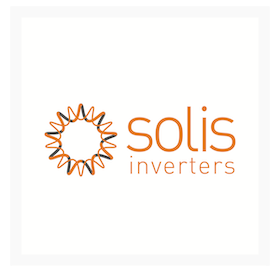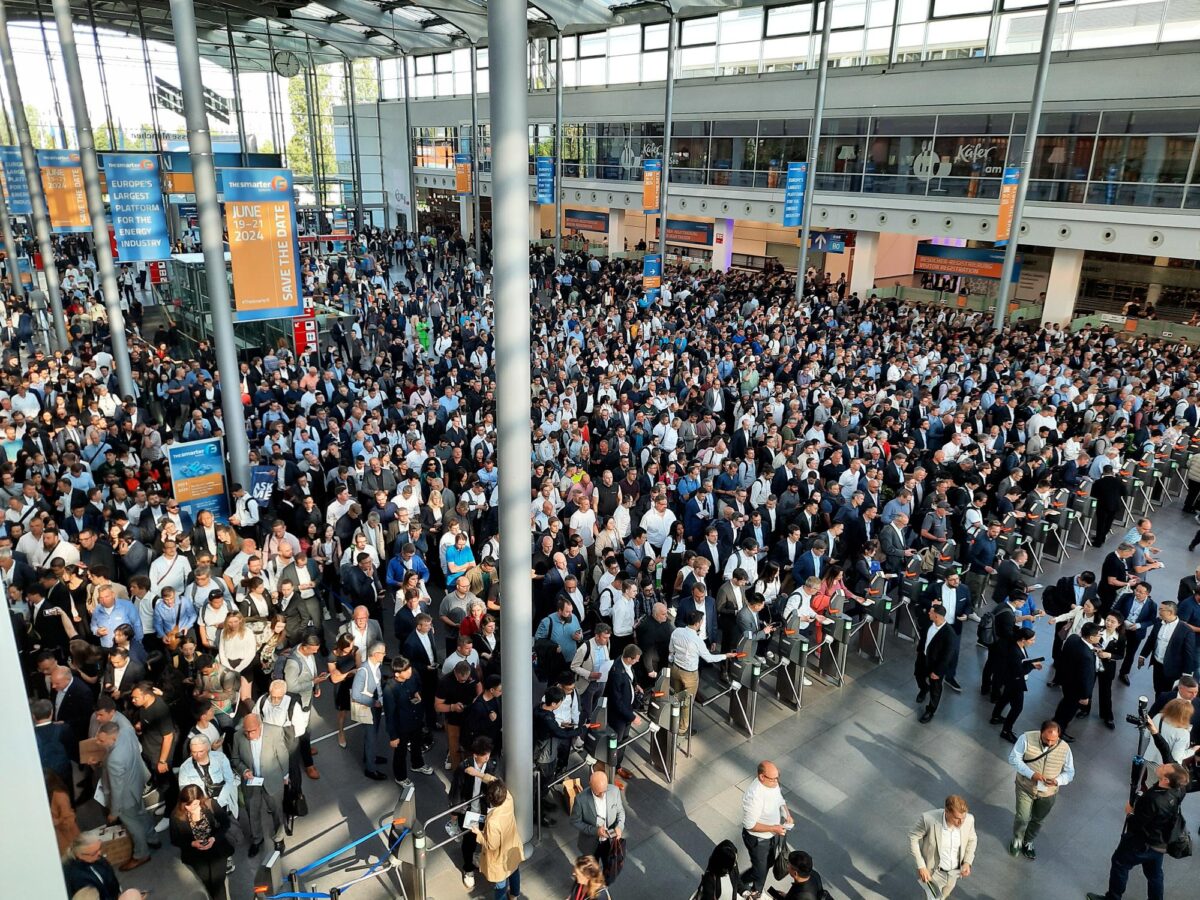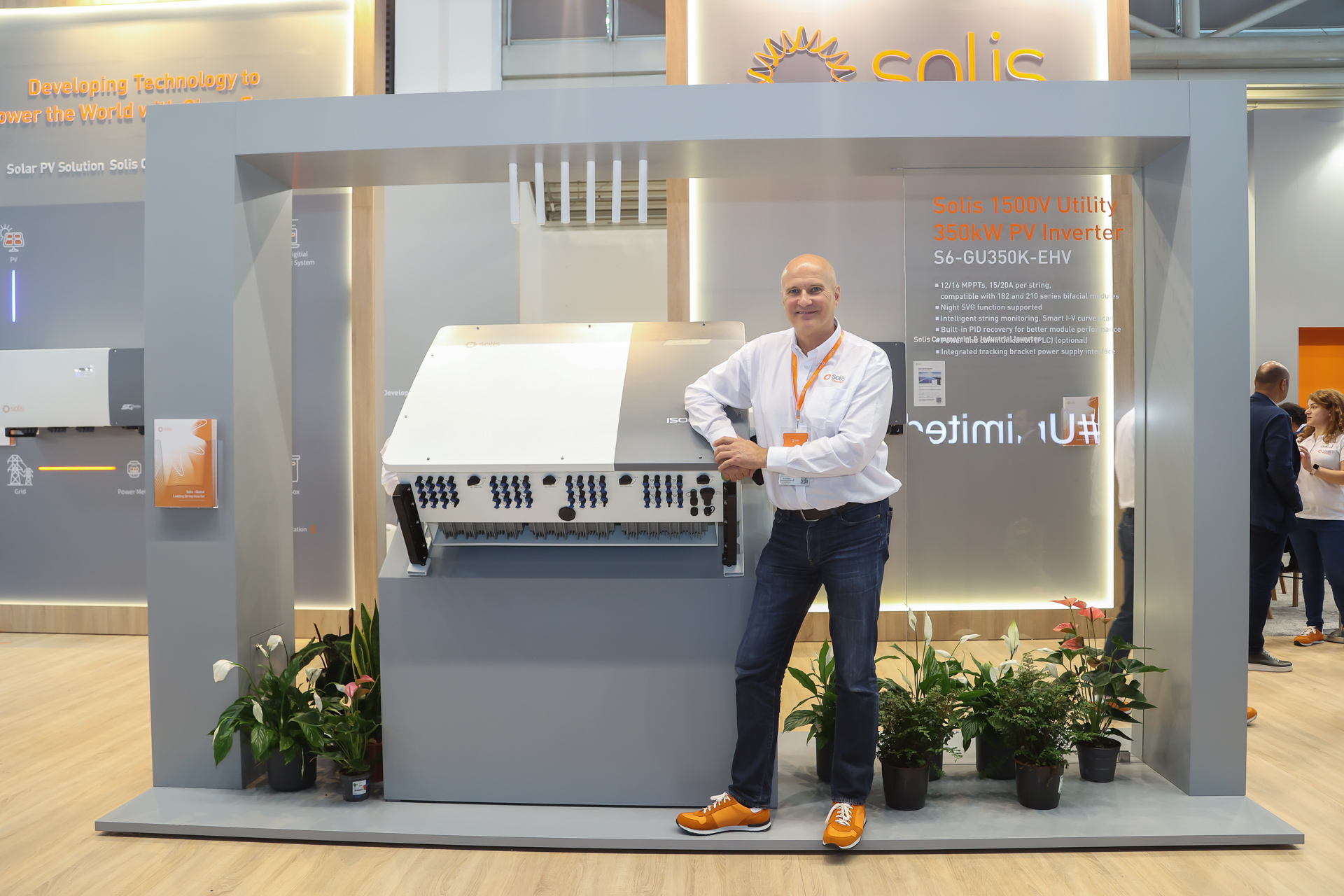
New Solis exec sets sights on European utility-scale solar market
Expanding its team and presence in Europe, Solis recently hired Gregory Lukens as the new Director Utility Europe. pv magazine’s editor-in-chief Jonathan Gifford caught up with Gregory at the Solis booth at Intersolar, where the company was showcasing its new lines of inverters for utility-scale, C&I, and residential markets.
Gregory talked about plans for the near-future at Solis, where his first focus will be “to complete certification of our existing machines for the remaining European markets where that needs to be done. And which will be done in the next several months, so we’re working very hard on this.”
He also talked about Solis’ commitment to go after the utility-scale market in Europe, recognizing that inverters are just one piece of the puzzle for solutions to fulfill customer needs. Gregory says his time at Intersolar is focused on meeting with potential partners, with the ultimate goal of “orchestrating the commercial agreements to make it all happen.”
As Solis grows its team in Europe, it will be focused on attracting and hiring salespersons not only for the utility-scale market, but also for its inverters for C&I and residential applications.
You’ll be able to read the full interview between Jonathan and Gregory in the coming days as we continue our reporting on happenings at Intersolar Europe 2023.
You can see the latest utility-scale inverters from Solis at their booth in Hall B3 (B3.430).
Tesvolt offers cash back on new batteries
“There are indicators in the battery energy storage sector that we should continue to ramp up supply, particularly in the small commercial market segment,” says Christian Löffler, product manager at Tesvolt. “In Germany, for instance, there are many farmers that have already switched to solar and are now looking to attach a battery.”
At this year’s Intersolar, the German battery specialist is presenting its new generation of battery storage systems, TS HV 30-80 E, specifically developed with small businesses in mind, writes Marija Maisch.
The three new energy storage systems (in 30 kW, 50 kW, and 80 kW sizes) incorporate Tesvolt battery modules, each with the latest-generation Samsung SDI cells. New features include the Sunny Tripower Storage X three-phase battery inverter, from SMA.
“The energy management system in our latest products enables multi-use applications such as self-consumption optimization, peak shaving, and managing of EV charging infrastructure, as well as those we may not even know about now but may prove profitable in the future” says Loffler.
He says Tesvolt’s EMS interface can communicate with any brand for energy generation or on the load side, which makes it particularly versatile. In its next version, the product will be available with a backup functionality.
The TÜV-certified TS HV 30-80 E will be available on the market next month and can be delivered within six weeks to eight weeks.
Tesvolt is offering a generous cash back for end-customers in the DACH region, of €80 ($87)/kWh on the TS HV 30-80 E purchases in combination with its Tesvolt Energy Manager (the TS HV 30-80 or TS-I HV) until the end of September.
Racking up customers
At the booth of Austrian PV racking manufacturer Aerocompact, pv magazine met up with CEO Dirk Morbitzer, writes Eckhart Gouras.
Aerocompact is bringing a new mounting solution to market that is specifically engineered for traditional tiled roofs.
Instead of cutting through tiles to mount the racking, installers can simply lift out the tiles and mount the racking directly to the beams below them.
The solution provides waterproof sealing and being anchored directly to the roof beams it allows for higher loads and less mounting equipment being installed on roofs, saving installation time and cost.
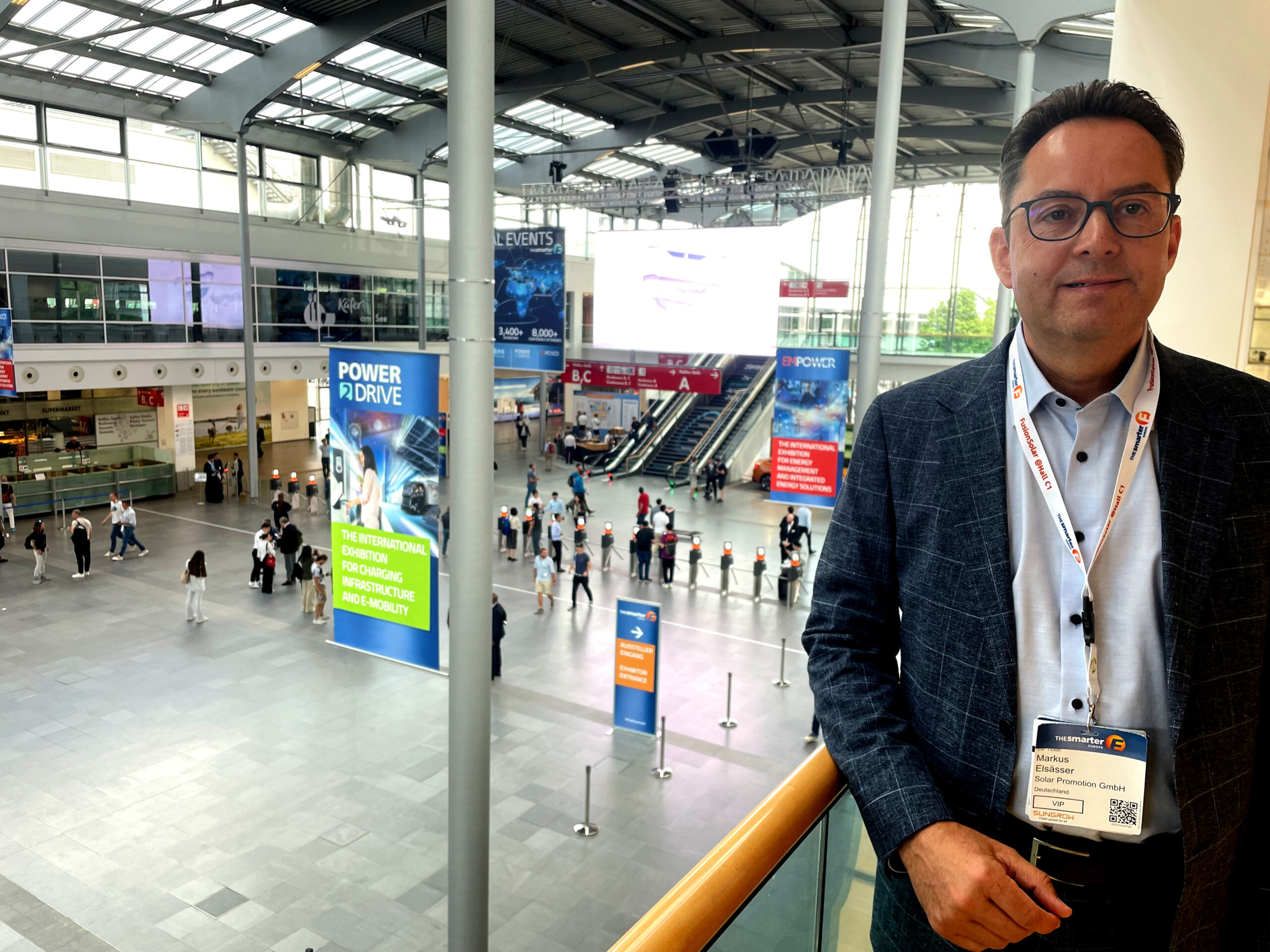
'Biggest show ever'
As the exhibition halls begin to thin out, Jonathan Gifford caught up with our host in Munich, the founder and CEO of Solar Promotion, Markus Elsässer. He had many reasons to smile.
Across the three days, The smarter E Europe show – of which Intersolar is a part – attracted 100,000 visitors, Elsässer says. And they had plenty to see, with almost 2,5000 exhibitors.
“I hope that everyone will be back next year,” Elsässer said, “these sectors are growing together more and more, the electric vehicles, the renewable generation, storage, power-to-heat, and everything growing together. We are just at the beginning of the transformation of the energy and mobility world into a new renewables, digital, and decentralized world. This is an exciting journey and it is great to see it finally happen.”
The smarter E Europe show will return in 2024, from June 19 to June 21.
The pv magazine quality mark
Gamesa Electric is proudly showing off its award-winning Proteus PV central inverter in hall B3, after it took home the pv magazine Award for Inverters in 2022 – see the badge!
The inverter category is set to be hot competition again this year, and don't forget you can enter your products across a range of categories here, from August 1.
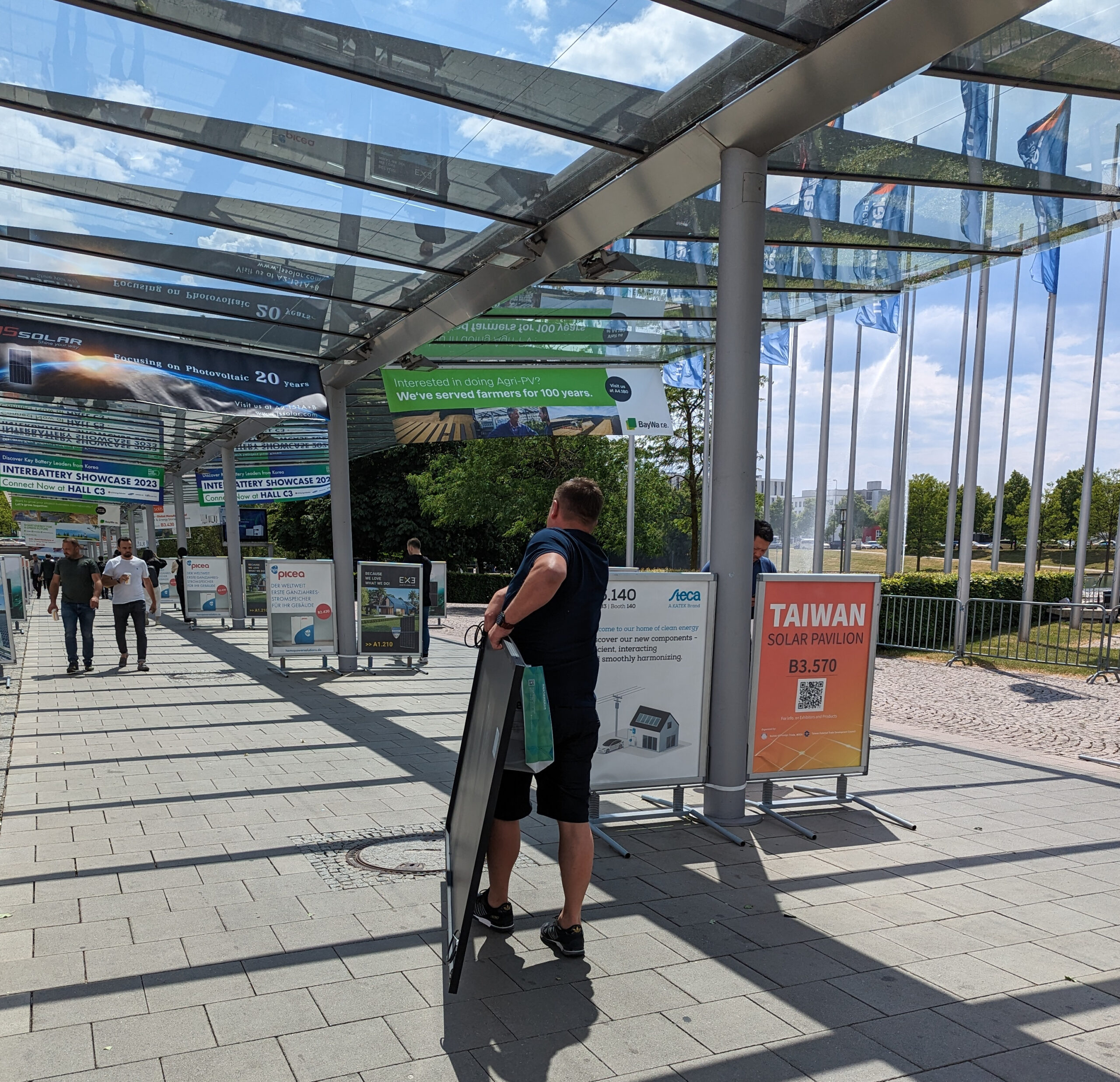
Hold on a minute...
Our Tristan Rayner‘s spotted it's already packing up time for some of the exhibitors eager to beat the exodus.
Stacking sonnen storage
Before leaving the exhibition halls and heading west today, Intersolar attendees can stop by at battery manufacturer Sonnen in Hall B1 – although “battery manufacturer” is no longer really accurate, writes Cornelia Lichner.
For its customers in the Sonnen community, the company is much more: energy supplier, smart home manager, and provider of balancing energy for the grid.
For a few years now, Sonnen has provided primary control power using its customers' storage systems and it has recently also integrated electric vehicles.
If the frequency increases and there is not enough load in the grid, Sonnen can charge a vehicle fleet and, in the opposite situation the battery storage systems can feed electricity into the grid.
In addition to primary control reserve, Sonnen is active on the spot and day-ahead electricity market. As a result, the company has managed to keep energy prices stable for its customers over the past year, according to Tamika Balken, Sonnen Product Manager for Virtual Power Plants.
Other news from the Sonnen ecosystem concerns big storage. The sonnenPro FlexStack is a large white cube. Two are required for the minimum output of 92 kW with 110 kWh and a maximum of four cubes offer 495 kWh and 368 kW of power.
The outdoor storage system is suitable for commercial and industrial customers, for example to enable the introduction of electromobility.
Sales will start at the end of October in Germany, Spain, and Italy.
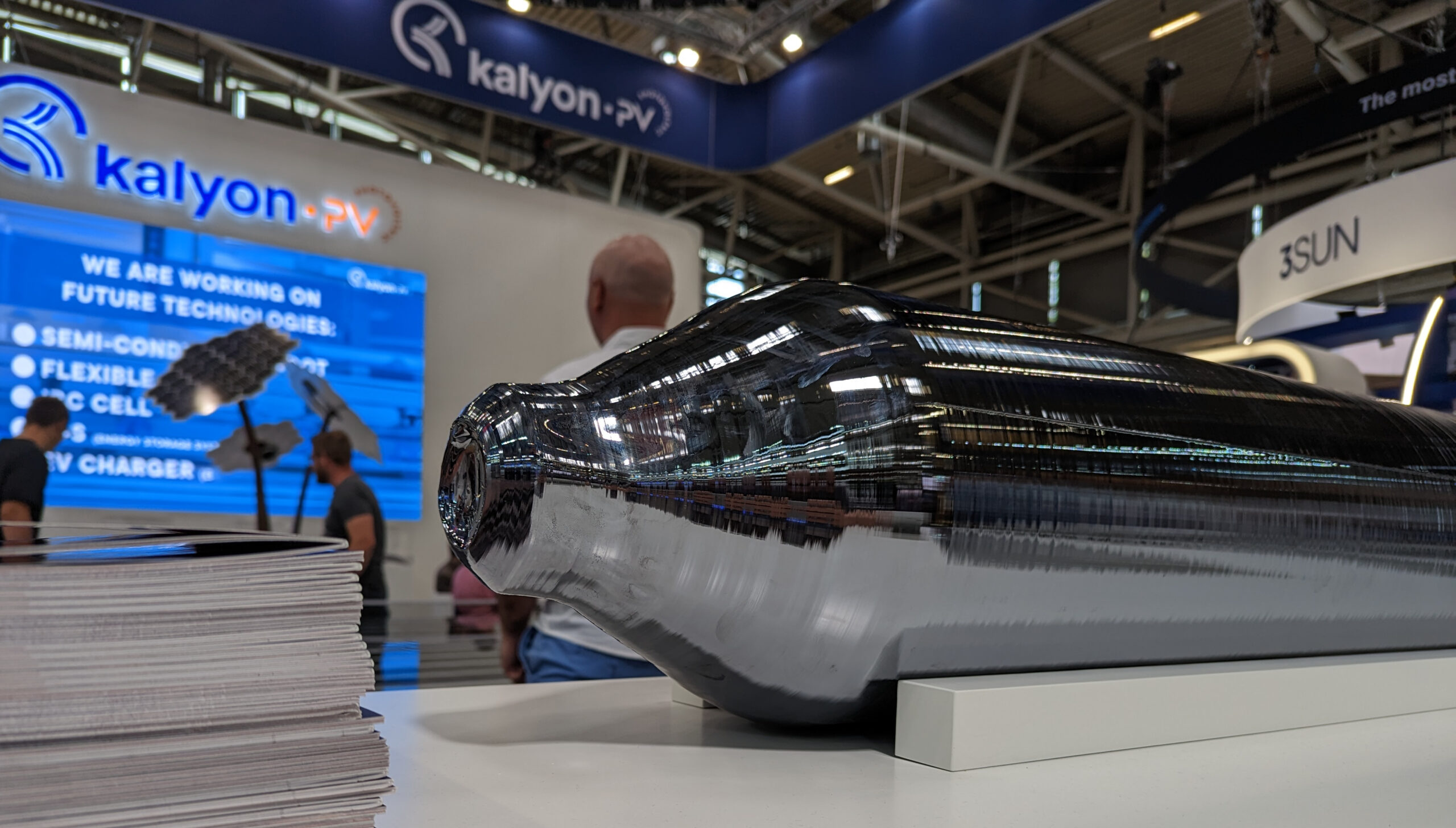
Ingot catches the eye
Turkish solar manufacturer Kalyon PV is showing off its full production capability at Intersolar, from polysilicon, to ingot, wafer, cell, and module manufacturing, writes Tristan Rayner.
A full ingot, cooled down somewhat from its 1,500 C furnace temperature, is on display.at the Kalyon booth. The 228 mm diameter version on show is full sized apart from its usual 4 m length, with production ingots weighing around 350 kg to 400 kg.
Kalyon told pv magazine the factory produced its first TOPCON cell and module recently and the company is hoping to start large scale TOPCON production within three months to four months.
After the show packs up
Steel in need of a solar fix after the booths begin to come down this afternoon?
Check out the current issue of pv magazine, which you can subscribe to here.
In the June issue of pv magazine we turn the spotlight onto European solar with a comprehensive review of the state of the PV industry across the region’s key markets and a look at the legislation which aims to drive a solar rooftop boom. We also examine the difficulty of establishing a solar panel recycling industry in Australia, where industry backbiting isn’t helping matters.
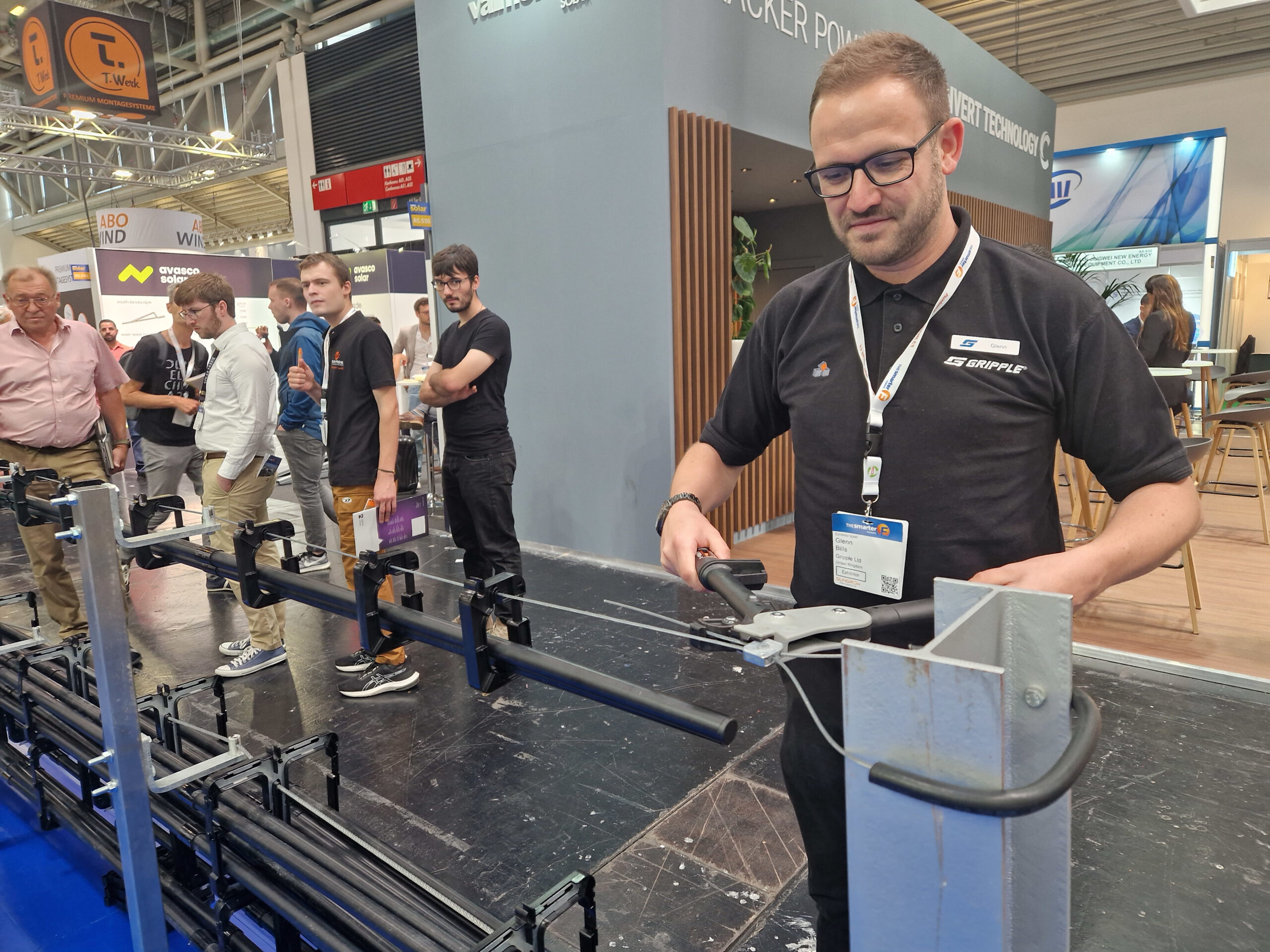
Getting to grips with cabling
Towards the back of section A at Intersolar, suppliers of varied balance-of-systems products have their wares on display, writes Mark Hutchins.
pv magazine dropped in to visit UK company Gripple for a demonstration of its cable management system, which sees cables suspended from steel wires and clipped into place using specially designed plastic holders.
Business development director Glen Bills explained the system promises big savings in the long run, since the alternative is to bury cables, which can be a major challenge later on when it comes to maintenance, and can also require cables with higher ratings to offer sufficient moisture protection.
Gripple also says its system should have a minimal impact on production – around 2% or less on energy yield for a bifacial system.
The steel wiring is connected to steel posts at either end of the row, with supports placed every few meters. In some cases, the system can be suspended from the panel mounting system itself, leading to further savings on steel.
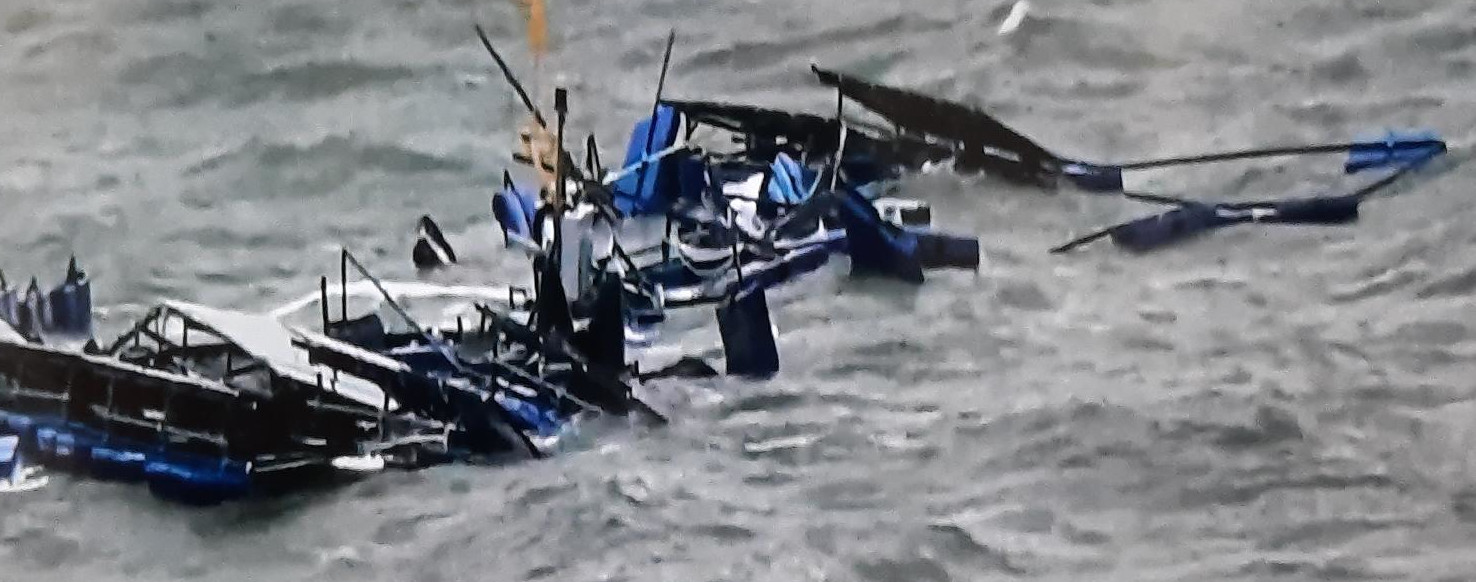
A floating disaster
While wandering the halls, our Cornelia Lichner spotted this image displayed on a screen at the booth of Eco Float.
The company would say only that the images are from a “competitor” in the segment.
European women in solar
This week marks the launch of Women in Solar Europe (WiSEu), an initiative that aims to address inequality and create opportunities for women in the solar sector, writes Tristan Rayner.
The group, which already has 450 members, hosted its first breakfast networking event this morning at Intersolar.
WiSEu welcomes anyone from the industry who supports its mission and the initiative is sponsored by Solis and Jinko, the founding partners who organized the breakfast event.
WiSEu will have a website within a few weeks but if you're reading this, you're in on the ground floor – the initiative is assembling on LinkedIn and you can find out more here.
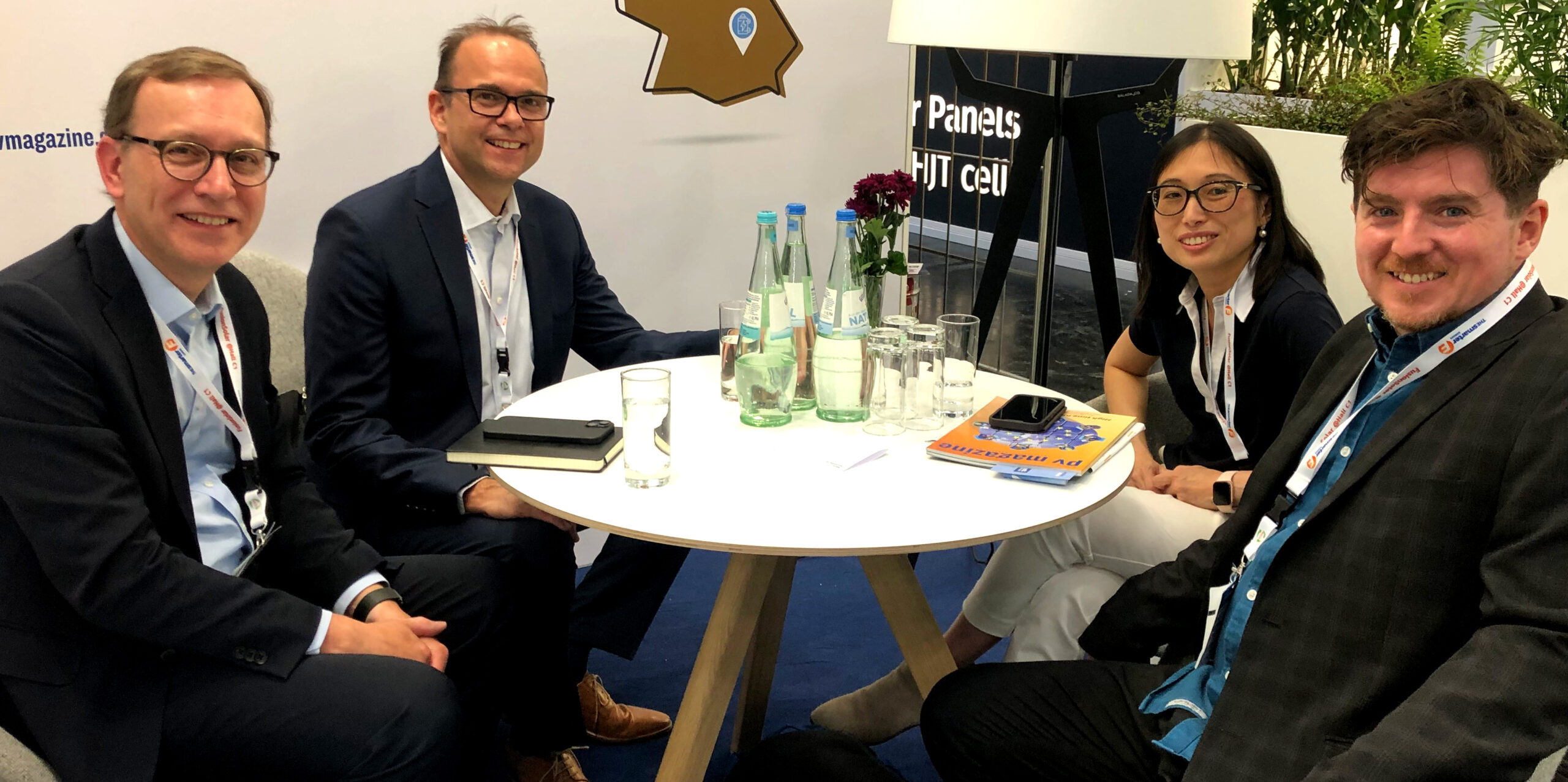
Sizing up tandem cells
Perovskite-silicon tandem cells are often dubbed “the future of PV,” and have been prominently mentioned in sessions during Intersolar – as well as at VDMA’s PV manufacturing stage over in the back of hall A2, writes Mark Hutchins.
Aside from a small preview at Q Cells’ booth, however, the technology is still largely absent from the show floor, suggesting challenges remain in the way of commercialization.
This may be about to change, however. Oxford PV has been working toward commercial production of tandem modules at its site in Brandenburg for a few years now, and when pv magazine met with CEO David Ward this week, he said the first modules are expected to roll off production lines in early 2024, with the line to scale up to its full 100 MW capacity over the following months.
Ward said the company’s focus is now entirely on pushing higher efficiency on “full size” wafers, leaving the higher efficiency records achieved on small devices to academics and research institutes.
The next step for the company will be submitting its module for testing and certification from the IEC and other bodies.
“Commercial size is what matters,” said Ward. “And at this point it’s less important what we say, and time to hand over to the certification bodies.”
New hires, no fires
“There have been between 17 and 19 battery fire issues in Germany tracked via social media this year, and only one from Senec,” says Markus Linder, Senec’s newly appointed chief technology officer. “In this case, it was only one cell burning.”
Linder says the German battery provider has a strategy of proactively reaching out to monitor non-normal issues. “We harvest the battery cells and modules produced on the same day as the ones that have displayed defect potential, as well as those in a similar use profile, and then we send them to external institutions to evaluate,” he says.
“This is why the low power mode remained for some users, but we have received no complaints. In fact, people would often say ‘I know there is a risk, but I want to run it.' But doing it properly takes time and we need to be 100% sure when it comes to the safety of our systems.”
As reported by pv magazine in March 2022, there were three reports of explosions in houses in which Senec products were installed. After those incidents, the company’s residential storage systems in Germany were automatically switched to a regulated standby mode. Earlier this year, another incident was reported.
Senec has also appointed a new director for batteries: Ramesh Natarajan.
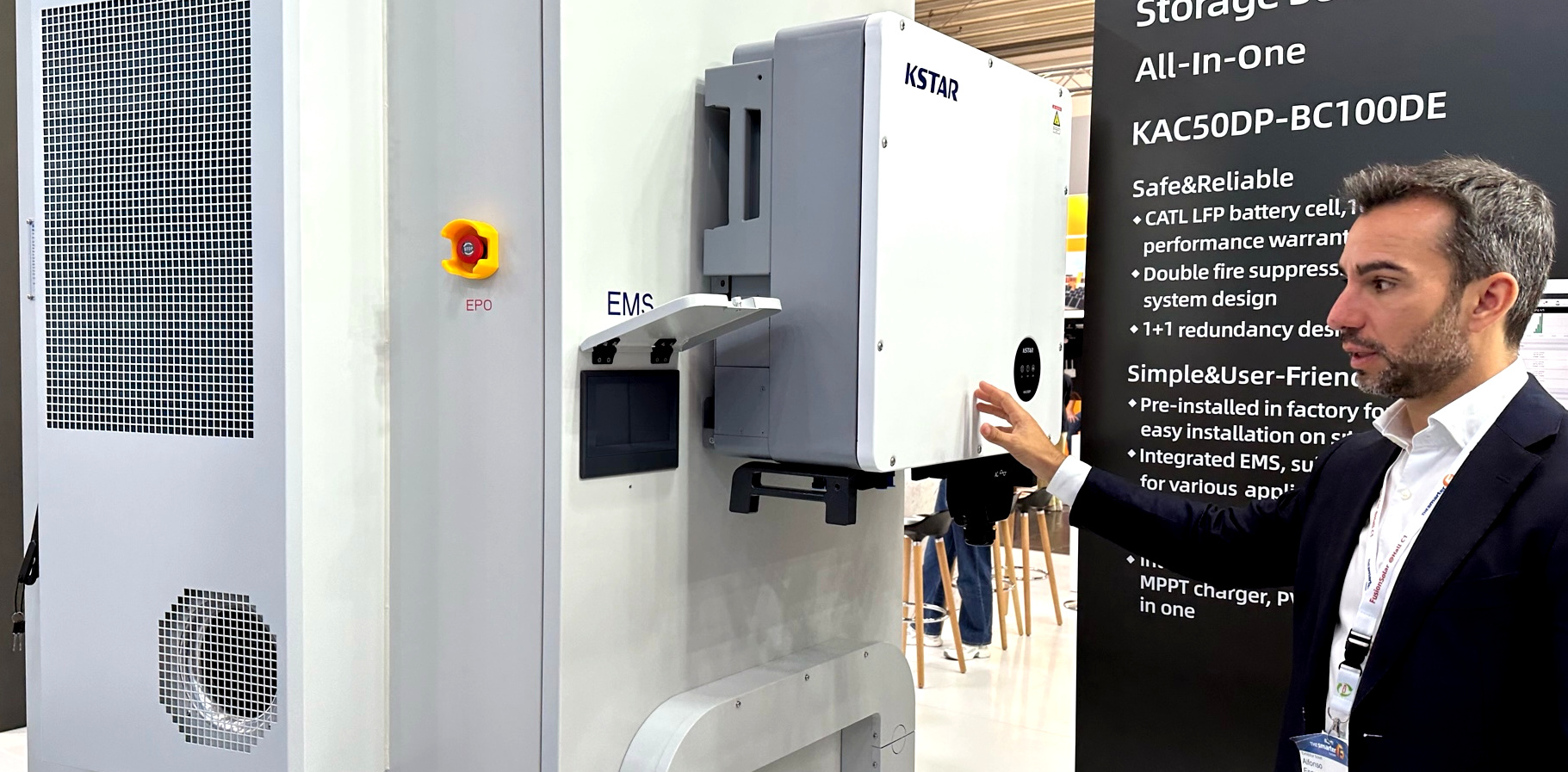
C&I storage writ large
There really is traction building for energy storage in Europe's commercial businesses, says Alfonso Escuredo, country manager for Spain at Kstar.
After a troublesome year on the energy markets, businesses are looking for ways to reduce price volatility, writes Marian Willuhn. Storage and PV are proving to be the shield of choice.
Kstar has heeded the call and is showing its new 100 kWh storage battery at Intersolar.
The system comprises two 50 kW stacks of CATL cells, neatly tucked away in a IP55-protected cabinet. The battery can be kept outside without worry, Escuredo says. The system also features air cooling which distributes any heat build-up evenly among the cells. It also features module-level and cabinet-level fire suppression, in case it gets really hot.
On the outside of the cabinet, Kstar's 50 kW hybrid inverter is screwed on. The inverter can connect to 75 kW of solar power and discharge with a maximum of 50 kW, enough to power the big loads of manufacturing operations, for example.
It is not just high power prices that storage can protect against. Power outages are a real show-stopper for any industry. In such cases, the Kstar system can create a microgrid and keep machines running. If needed, up to 20 batteries can be connected in parallel, for extra oomph and, if variety is needed, a diesel gen-set can also be connected.
Escuredo believes Kstar will sell something like 10 MWh of the systems in Iberia this year.
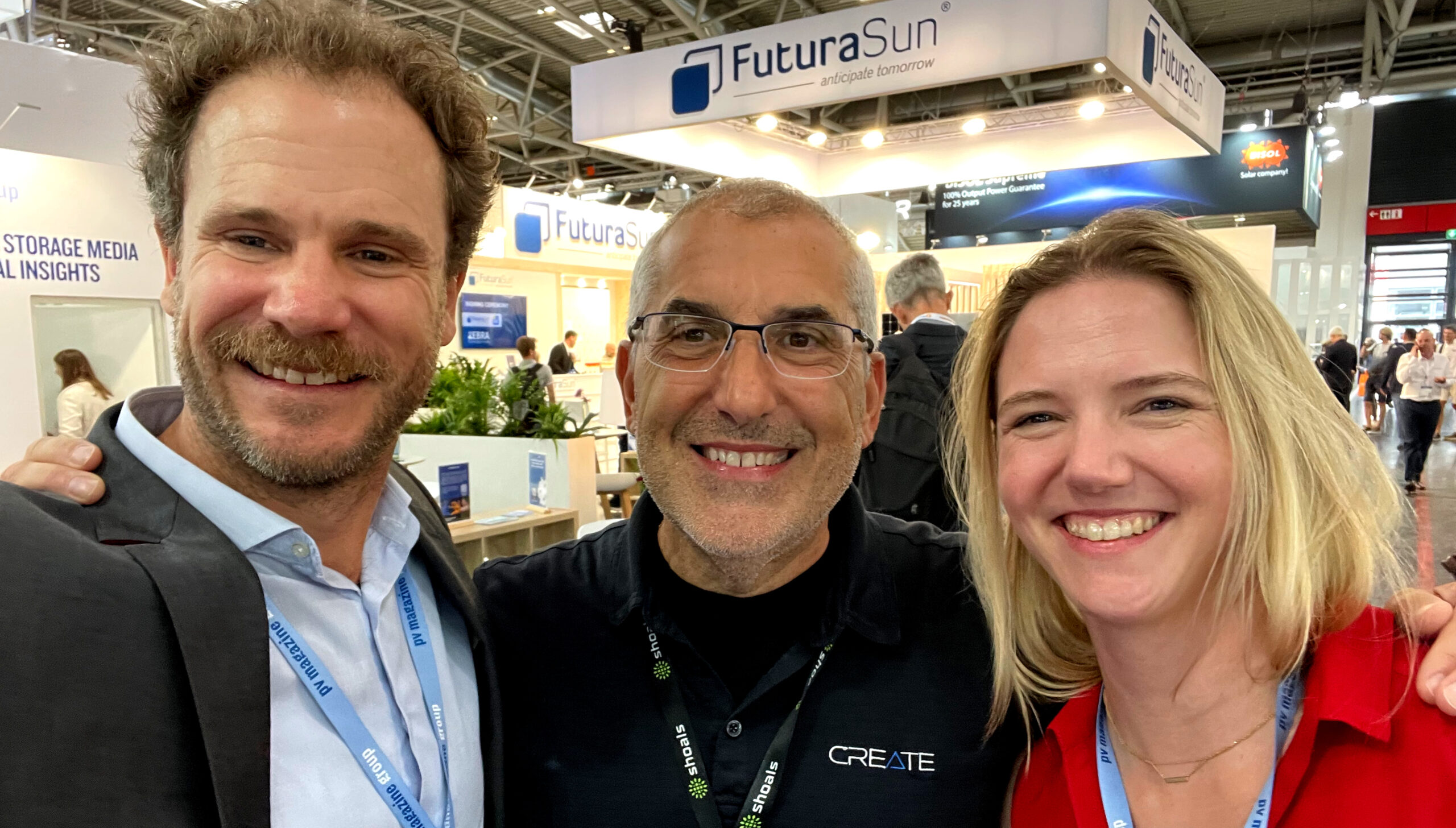
You can’t keep a good Dean down
Life after IPO can’t keep Dean Solon, founder and former CEO of solar electrical gear manufacturer Shoals Technologies away from solar events, writes Jonathan Gifford.
The freshly minted billionaire was looking lean and full of energy on the Intersolar trade show floor.
He’s currently kicking the tires of solar and energy storage and considering making an investment – if, that is, they can stand up to his rigorous demands.
Reliability issues with glass-glass modules?
PVEL’s Tristan Erion-Lorico and Sishir Garemella say they have been contacted by multiple project owners about high levels of breakage in glass-glass modules that were not caused by hail or other extreme weather conditions, writes Mark Hutchins.
The independent testing lab representatives say breakage to glass on the rear side of modules is particularly prominent.
The cause is not immediately clear but insufficient testing for compatibility with trackers and mounting systems seem a likely place to start and the fact many manufacturers use on multiple glass suppliers muddies the waters further.
This may be a worrying development for the European module makers on the show floor this year, who for the most part have glass-glass products front and center.
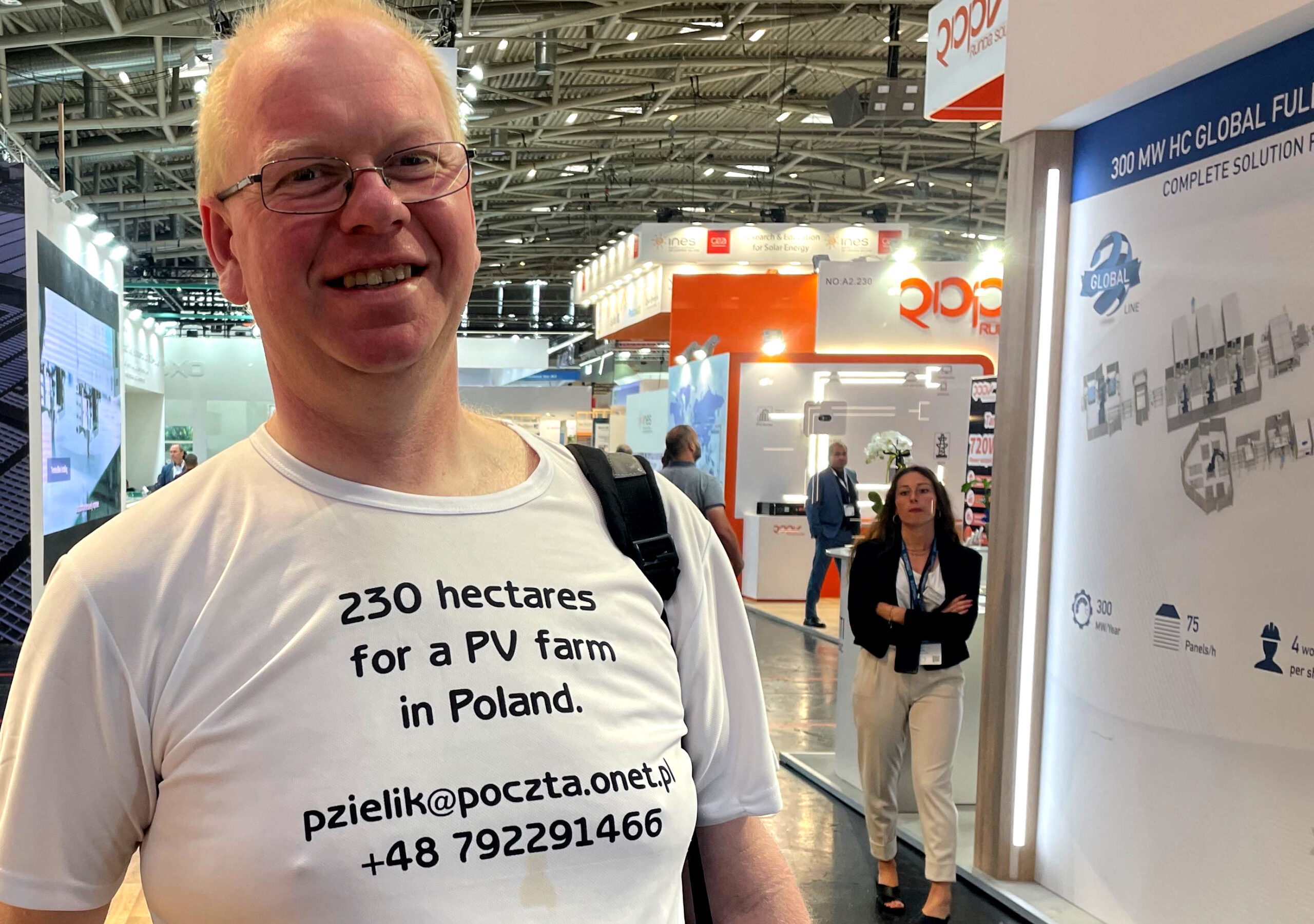
Looking for land in Poland?
Sometimes simple methods are the most effective, writes Jonathan Gifford. At least, that’s what Pawel Zieliwsk is hoping. He wants to offload 230 hectares in Poland for solar, or possibly wind, development.
The enterprizing Pawel made a t-shirt to advertise the fact. Style meets substance, you might say!
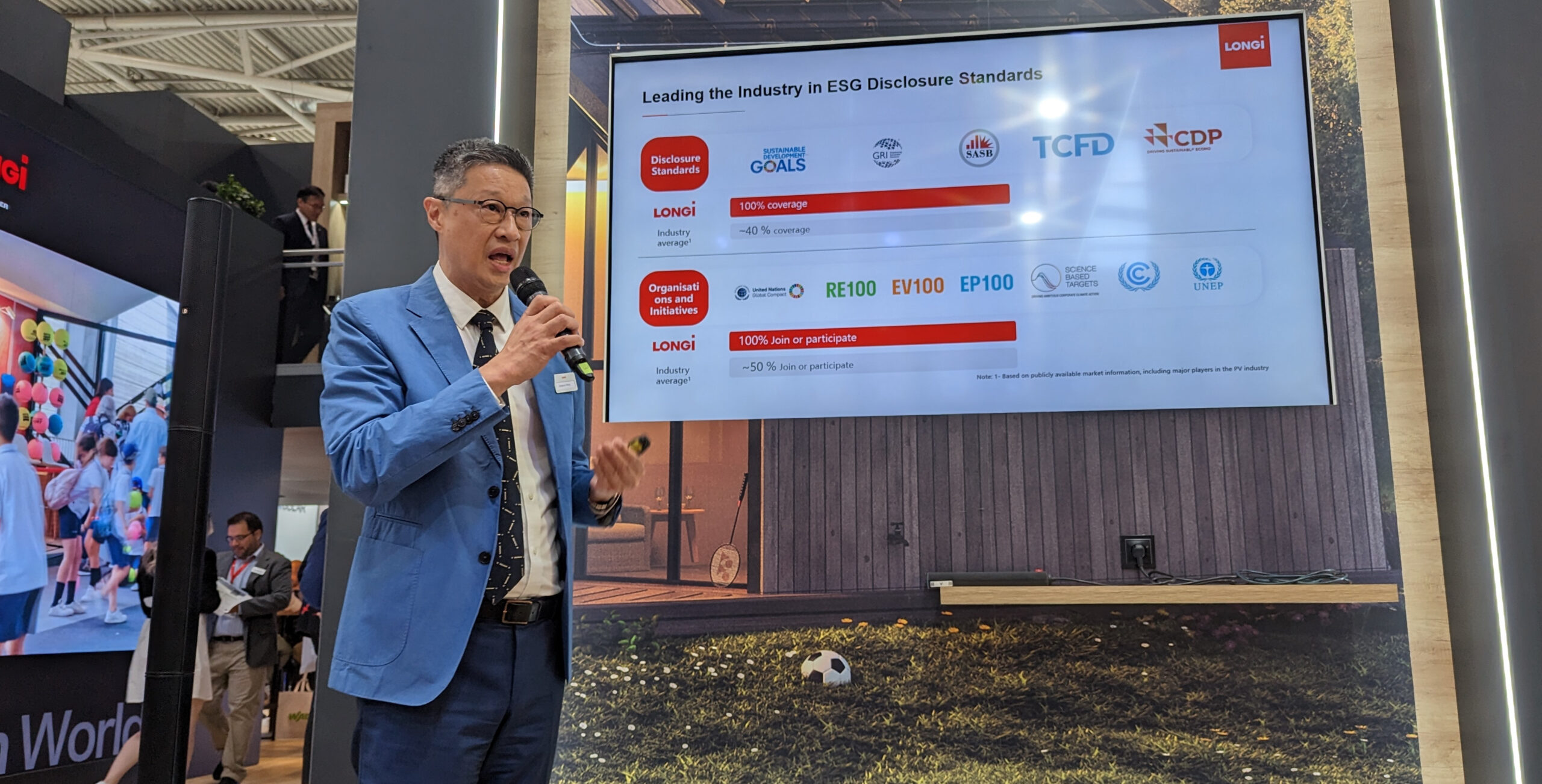
Longi showcases its sustainability ambition
Longi presented its 2022 Sustainability Report at Intersolar Europe, bringing facts and figures to the world of ESG [environmental, social, and corporate governance] reporting, writes Tristan Rayner.
The presentation of the certified report was refreshingly honest. Benjamin Wong, associate director for strategy and public affairs, explained Longi's emissions have risen from 2020, to 2021, and 2022, with Scope 1 emissions – arising directly from Longi operations – rising, in 2022 to 158.2 tCO2e, up from 94.8 in 2021.
Longi's production rose by more than 100% during that time, however, Wong said, with Scope 2 emissions – associated with the purchase of services such as heating and cooling – falling, and the solar manufacturer's efforts to operate using 100% renewable energy remain on track.
Speaking to pv magazine, Wong said: “Without transparency, without honesty, it's just greenwashing,” and he noted Longi's internal support for accurate and detailed reporting.
Externally, the company is also supporting the EU's moves to standardize sustainability and ESG reporting as part of its Corporate Sustainability Reporting Directive, which is being phased in for large companies. In addition, Longi has supported SolarPower Europe's efforts with its Solar Stewardship Initiative, a solar-specific sustainability assurance programme.
An Intersolar walk-through
Enough with all the words! Let's have a wander around the show so you can get an idea of what's going on.
[𝗧𝗥𝗔𝗗𝗘𝗦𝗛𝗢𝗪🚊] Last day at @Intersolar!
Today marks the final day of #Intersolar! We gained interesting impressions, discovered groundbreaking new technologies and had interesting discussions!
Check our #liveblog for more highlights: https://t.co/ZuslXqnJcD pic.twitter.com/n96IcFIw2J— pv magazine (@pvmagazine) June 16, 2023
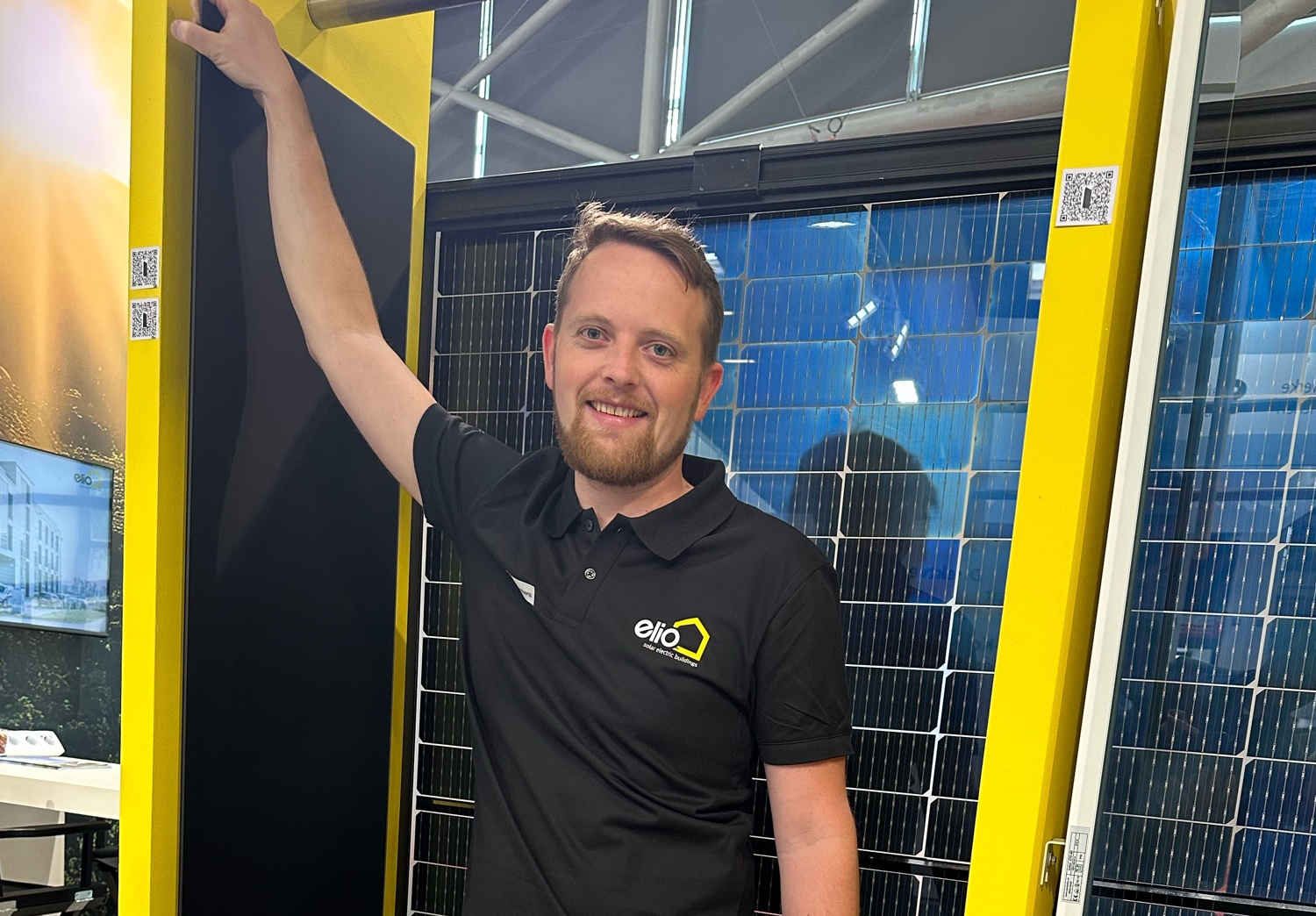
Infrared – chic and economical if you do it right
Because they're so unobtrusive, here's a quick reference to Elio's infrared heating elements, writes Cornelia Lichner.
The company at B5.530 of Intersolar is showing its heating panels for a wide range of applications.
Above all, infrared heaters are fast. When a person enters a room, a motion detector reports their presence and the heating starts with pleasing warmth spreading within a few minutes. The heating goes off again just as quickly as a person leaves the room.
This is a very economical way of heating, especially in rarely-used rooms and it can be easily combined with photovoltaic production, says Elio's Dirk Bornhorst.
Another possibility is combination with a small heat pump or gas heating. These take over the economical, basic temperature control of a room with infrared heating the tips.
A study by TU Dresden simulated the concept and predicted significant savings in investment costs and operation.
Infrared heating will be examined in more depth in a heating feature in the next edition of pv magazine Germany.
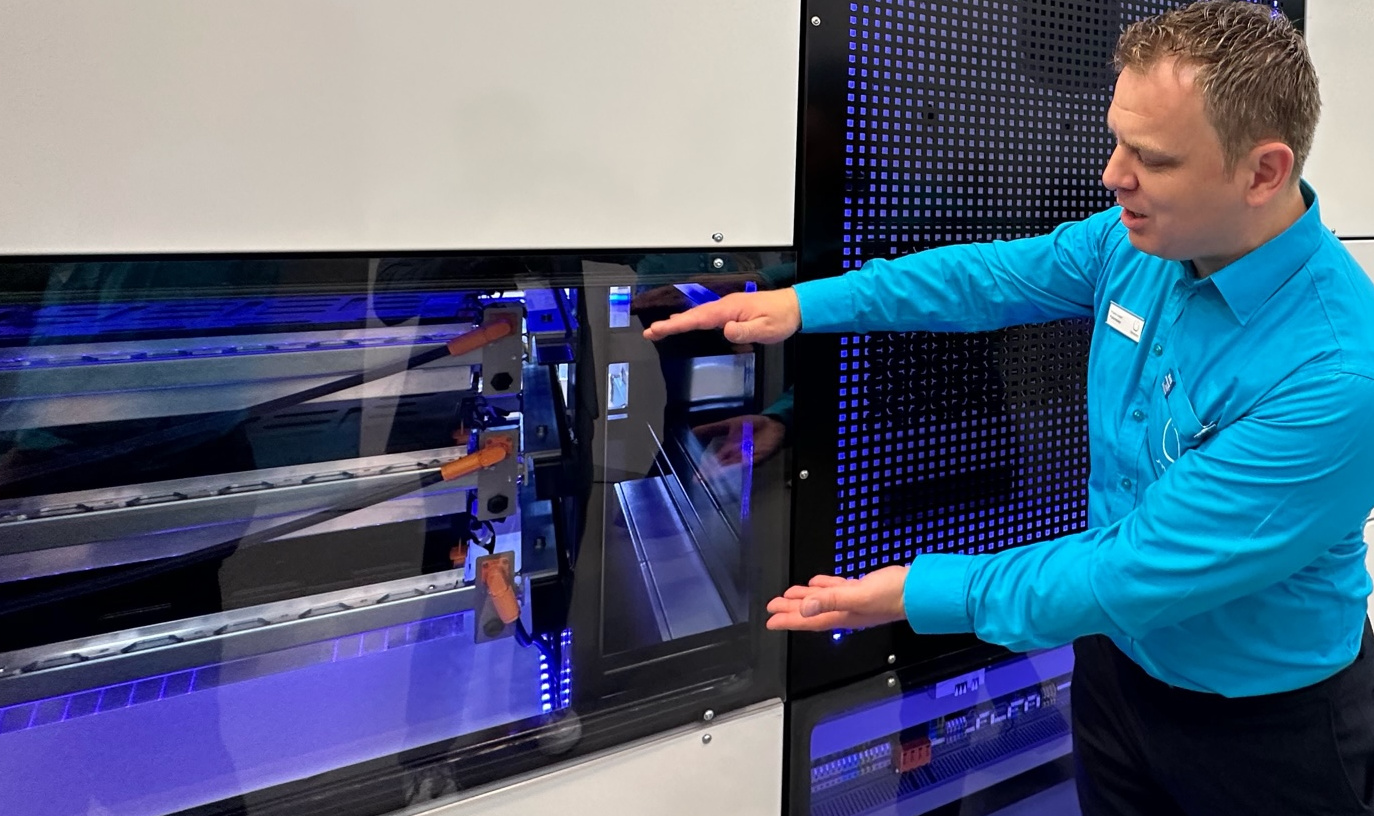
From Mercs to award perks
You never know where life is going to take you, writes Marian Willuhn. The CATL battery cells pictured above, for example, were supposed to end up in the packs of a shiny new Mercedes electric vehicle. Supply chain disruptions of parts such as micro-chips and cables, however, delayed the manufacture and, after 365 days, the cells are not permitted for use in a car any more.
Now the cells have ended up with Franz-Josef Feilmeier and are winning awards as part of the energy transition instead. The CEO of storage system maker Fenecon bought 126 MWh of the batteries and gave them a new life in large-scale storage.
The batteries have a power rating of 736 kW and a capacity of 1,288 kWh. Inside are eight 92 kW inverters – each connected to its own battery. This modular design ensures high conversion efficiency rates at partial loads, as the system can bypass inverters to increase the load on the units it uses. The design on Wednesday earned Fenecon an ees-Award for innovating energy storage.
And award jurors weren't the only ones impressed. Systems like these are sought after by German PV plant operators, Feilmeier says.
There is a visible trend of co-locating big storage with PV. The battery and PV system are economically independent but they can use the same grid connection, saving a lot of costs. With frequency services and arbitrage business thrown in, project developers can amortize the cost of storage systems in less than four years in Germany.

Big storage as a trouble-shooter
Manufacturing problems are similar everywhere, says Guy Schaaf, from French large battery maker Socomec.
Grid expansion in cities, and especially in the countryside, is taking too long for the fast pace of the energy transition, writes Cornelia Lichner. Consumers and industry want electric cars and photovoltaic systems now, they don't want to wait until the grid operator has laid new cables or installed a new transformer.
That is why demand is increasing for large battery storage systems which can be entrusted with tasks such as capping peak loads, boosting charging infrastructure, and ensuring the self-supply of electricity is constantly increasing.
Commercial and industrial companies are exploring battery potential and grid operators and energy producers, such as PV site owners, are also in the market.
The trend is moving away from container-based solutions towards a more open, maintenance-friendly architecture, says Schaaf. The new storage systems presented by Socomec have a modular structure and consist of a battery cabinet and a cabinet with the power electronics and grid connection.
Socomec's portfolio has been expanded by the new Sunsys HES L power storage system, with outputs and capacities of up to 600 kVA/1,674 kWh; and the Sunsys HES XXL outdoor power storage system in versions up to 1.5 MVA/5MWh. This will be exhibited for the first time at the ees Europe part of Intersolar, at booth B2.350.
The modular design is not only advantageous for maintenance it also improves safety. Any fire is limited to just one module, components can be replaced during operation, and technicians do not have to work in a cramped, hot environment.
Schaaf expects his company to continue to grow over the next few years by 10% to 15% each year and expects Socomec to benefit from its large team of locally-available technicians.
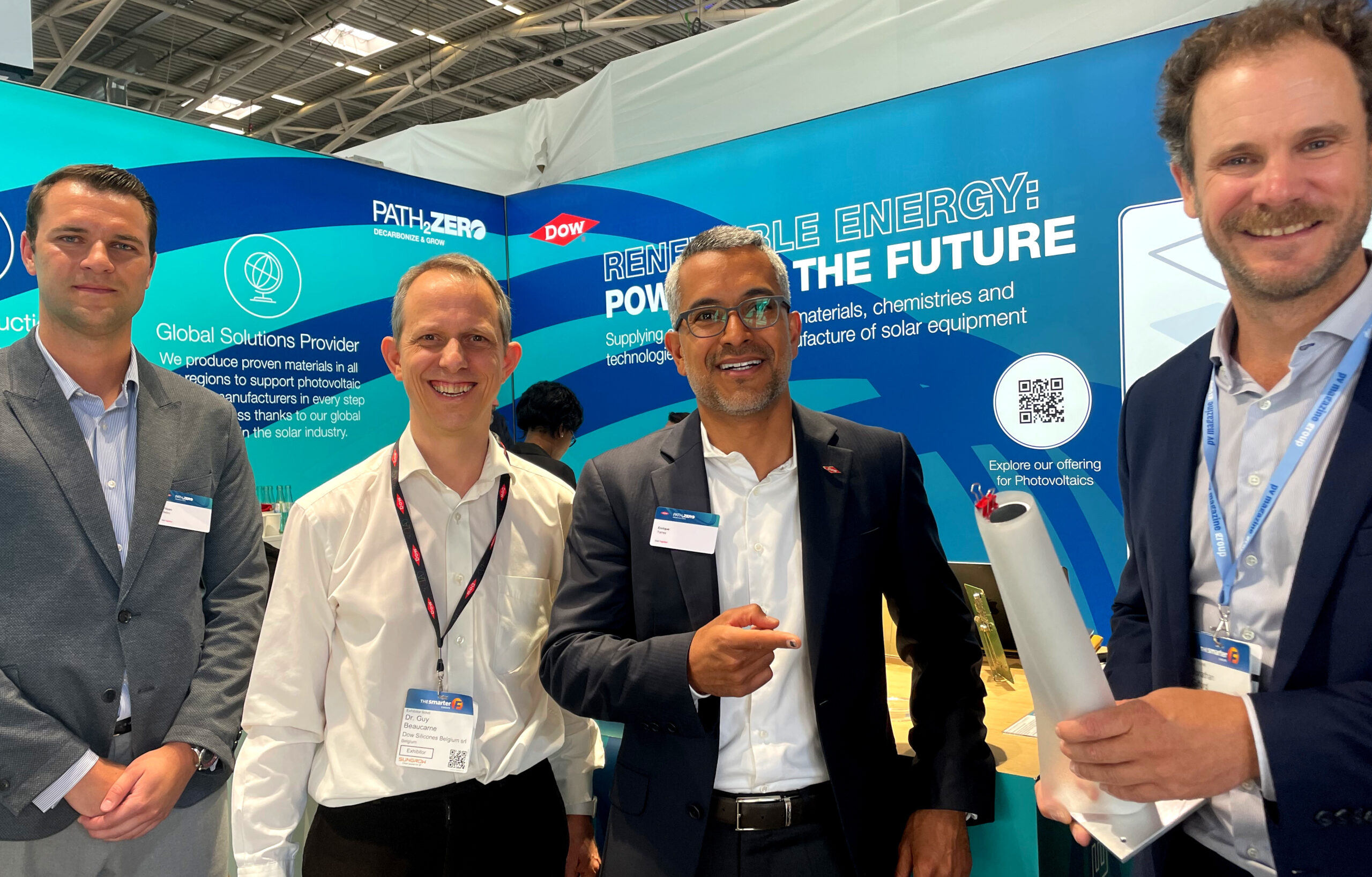
A focus on sustainability
In yet another sign of solar taking center stage in Europe, chemicals giant Dow has returned as an exhibitor at Intersolar 2023 after a multi-year absence, writes Jonathan Gifford.
With its team representing various Dow departments, the company is looking to provide chemical products to module makers.
Dow is perhaps best known in the PV industry for its supply of polyolefin (POE) to module encapsulant makers. POE offers long term durability and effectiveness in preventing water ingress and degradation. With the expansion of n-type technology, and a related panel sensitivity to moisture, demand for POE encapsulants is expected to increase.
Alongside POE, Dow also supplies a range of chemicals for glass-glass modules and potting agents for junction boxes, among other products.
Filippo Bellini, a business communications specialist with Dow says helping the PV industry manufacture more durable products aligns well with the corporation’s overarching business strategy – which puts sustainability front and center.
Is EU ready for the new Gen?
Geneverse is coming to Europe, writes Tristan Rayner.
That's the message from the US-based team which formerly offered home storage solutions such as portable battery storage and solar and including its recently launched HomePower Two Pro, a 2.4 kW power station for indoor use that is compatible with solar.
Now the company is targeting the EU and branching out into larger-scale storage and inverters. pv magazine was given a first look at Geneverse's step-up in ambition in the form of unreleased products including a 10 kWh to 25 kWh, modular stacked battery-plus-inverter solution, for an all-in-one home system.
The team was cagey on exact details: the product will launch in the US first, around September, with pricing from $5,000 to $25,000, depending on battery and inverter sizing.
In Europe, the plan is to launch the system shortly thereafter, with pricing less certain.
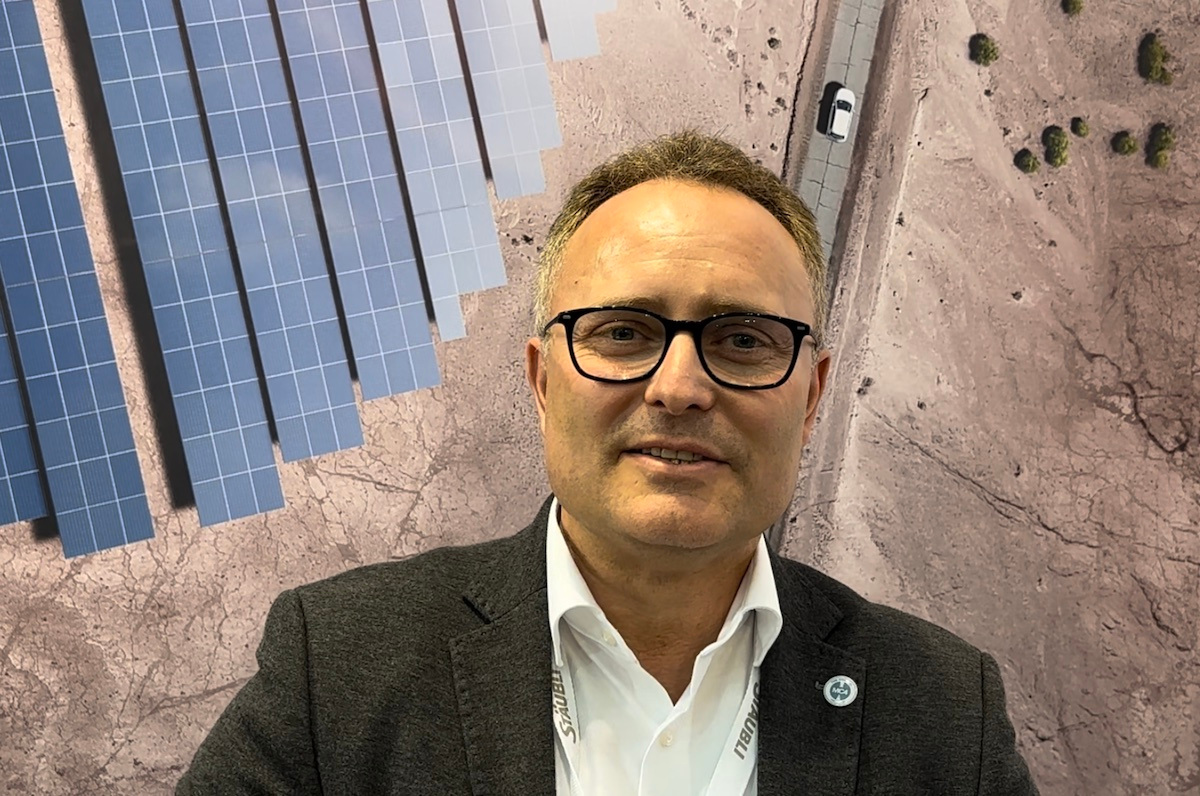
A market leader
It can be challenging to scale up production and maintain quality at the same time, writes Michael Fuhs. This not only applies to the photovoltaic modules, but also to connectors.
The Swiss market leader in photovoltaic connectors, Stäubli, is maintaining its grip on around half of the PV connector market, according to Matthias Mack, the company's VP for renewable energy.
Stäubli produces where its customers are – i.e. manufacturers of solar modules and module-level power electronics (MLPE) – and it follows three rules to maintain quality: Firstly, although production facilities are spread across the globe, Mack says, Stäubli uses a few key suppliers for its machines and qualifies them.
Secondly, when it comes to plastics, Mack says it is important to resist the temptation to use new, cheaper raw materials. “Quality problems, such as microcracks, are only noticed years later,” he says. The resulting damage is extensive, because you first have to identify the faulty connectors. That is why Stäubli uses well known materials with a long track record. Of the 1.1 TW of global solar generation capacity, Stäubli has supplied 650 GW worth, Mack estimates.
Thirdly, in order to maintain quality, the challenge of finding good staff at production sites and training them has to be overcome. Mack doesn't just see challenges in production, but also in installation.
“We still observe quite a lot of incidents with wrong installation,” he says – for example, with incorrect crimping and installation in bad weather conditions. Stäubli will, therefore, also expand its support of installation companies.
Not only module manufacturers are expanding, at the same time connector manufacturers have to scale up maintaining the reliability. Stäubli is keeping its market share of approximately 50%, says Vice-President Renewable energy Matthias Mack, explaining how to assure reliability. pic.twitter.com/6k5MbDyaex
— pv magazine (@pvmagazine) June 16, 2023
TBEA shows off string inverter
Inverter maker TBEA has flexed its muscles, dropping a 363kW string inverter for the European market at Intersolar, writes Tristan Rayner.
The TS360KTL-HV-C1 is already in its second-generation design, following 1 GW of installations in China for the first model. With 6 MPPTs, the 110 kg string inverter is billed as the most powerful in Europe.
The inverter derates at 40 C, to 330 kW; and at 60 C, to 230kW, with a short circuit ratio (SCR) of 1.0 – claimed to be the lowest in the industry.
TBEA also offers a complete MV transformer station at 3 MVA (megavolt amperes) to 9 MVA, inside a standard shipping container.
A TBEA representative told pv magazine the company tests its inverters in China, in both its own facilities and with partners for at least a year before rolling out second-generation products to market.
Other new elements in the pipeline include a 4.4 MW modular inverter which packs into a 40 ft shipping container with an inverter transformer station for up to 8.8 MW of power.
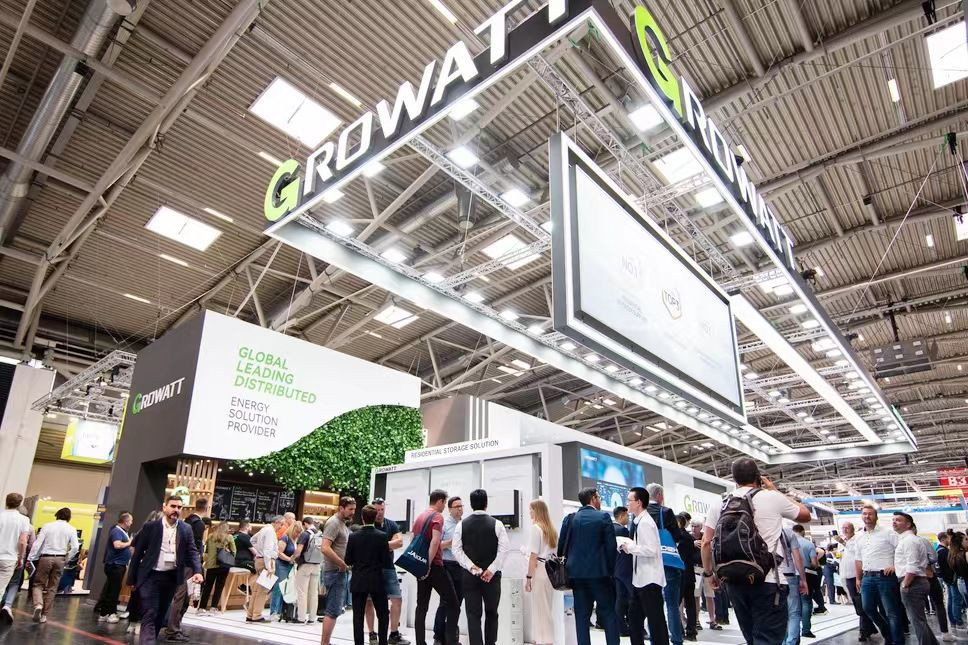
Getting ready for the future with Growatt
Long a major player in the solar inverter business, Growatt’s Whiskey Lu and Lisa Zhang have told Mark Hutchins energy storage products are representing an increasing share of the company’s business.
Zhang estimates around 40% of Growatt’s global revenue last year came from its energy storage offering and in Europe it already represents more than half.
Looking around the show floor, Lu noted a lot more companies are coming to the energy storage industry and competition is sure to be stiff for the next few years. Growatt, though, can enjoy a “first mover” advantage, along with its established position as an inverter supplier.
The company now advises all solar customers to opt for a battery-ready inverter, even for a PV installation being built initially without energy storage. This way, the customer is “ready for the future” and it will be significantly easier for them to add a battery later on.
